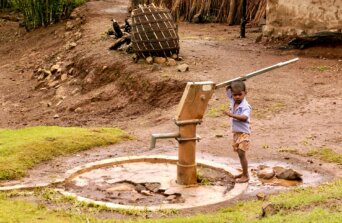- About
- Topics
- Picks
- Audio
- Story
- In-Depth
- Opinion
- News
- Donate
- Signup for our newsletterOur Editors' Best Picks.Send
Read, Debate: Engage.
| topic: | Innovation |
|---|---|
| located: | India |
| editor: | Bindu Gopal Rao |
Editor’s Note: This article is part of our groundwater campaign, in observance of the UN Water Day. Find more groundwater-related articles here.
As the world’s second-largest producer of rice and wheat, India is also the world’s largest consumer of groundwater in the world, a resource that is dwindling. This is a critical issue as 58 percent of India’s population depends on agriculture - a water-intensive activity - for its livelihood.
A 2012 report by the World Bank indicated that “India is the largest user of groundwater in the world. It uses an estimated 230 cubic kilometres of groundwater per year - over a quarter of the global total.” This number has now increased to 260 cubic kilometres of groundwater per year, ahead of both the USA and China.
There is little doubt that groundwater is a critical resource in the country considering 70 percent of the agricultural needs in India are quenched by groundwater. Since groundwater is invisible, it largely escapes the attention of policy makers. However, its importance is indisputable, and this is exactly why technology is coming to its rescue.
Take for instance MyWell, an app that can collect and analyse data related to well water-levels, rainfall quantity and water quality parameters. This is a community project that is being used in the Aravalli district in Gujarat, and the Udaipur district in Rajasthan, where hard rock aquifers are present. This is part of the MARVI project funded by the Australian Centre for International Agricultural Research and uses a village-level participatory focus to help improve groundwater supplies by involving farmers and other key stakeholders who are called ‘groundwater informed’ volunteers. The volunteers input data into the app by sending an SMS (on legacy mobile phones) or by using the app (on smartphones). They basically input water depth levels and all the data collected is used to understand how the groundwater levels fluctuate during the monsoon, as well as when they are being used to exhaustion, helping in effective management of groundwater. The application is being rolled out to more villages across the region.
Jaltol is a free and open-source geographic information system (GIS) application developed by scientists at the Centre for Social and Environmental Innovation (CSEI) in Bengaluru that is used to provide data around rainfall, changes in groundwater storage and soil moisture to help estimate water budgets in rural areas. This is an open-source tool, which is a plug-in that aims to improve 150,000 livelihoods in 2000 villages by 2030.
The use of artificial intelligence (AI) has also been a helpful tool to monitor the sustainable use of groundwater resources. For example, using smart sensors and Internet of Things can help match the available resources and the quantity of water withdrawn. Some practical applications of AI include controlling water wastage, especially due to issues like leakages and pipe bursts. For example, AI can monitor potential leaks in storage tanks, which is especially valuable since many tanks are connected to systems like bore wells that extract groundwater, which is then stored in the tanks. Furthermore, technology like machine learning and big data are able to monitor the quality of water in real time, therefore identifying water pollution before it affects human health.
The Watershed Organisation Trust (WOTR), a non-profit organisation, trains locals as part of its Water Stewardship Initiative (WSI). These volunteers measure water levels in wells that help water-governance norms, including limiting the depth of borewells. The inverse slope method is a software that can help monitor the thickness and resistance of different rock layers. Usually, low-resistance values of rock layers indicate a potentially higher groundwater level.
While these are only some examples, there is little doubt that technology can play a definitive role in ensuring an equitable distribution and sustainable extraction of groundwater.
Photo by Bradford Zak

